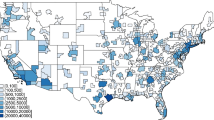Abstract
The US H-1B visa for highly skilled immigrant labor and the accompanying H-4 visa for their dependents lead to structural constraints that exclude dependents from the labor force. This paper investigates the economic consequences of the US immigration policy that decouples work and admission permission for H-4 visa holders. Using a pool of likely H-1B recipients who were recruited through firms’ job offers, we find that—despite labor force restrictions—the vast majority of married H-1B recipients are accompanied by their spouses. This is particularly the case for male H-1B recipients, making wives rather than husbands carry most of the burden associated labor force exclusions. Using a matched sample of married immigrants with work authorization, we estimate labor force participation probabilities and wages for the pool of likely dependent spouses if they were not facing work restrictions. We find that the policy-imposed labor force exclusion of H-4 spouses leads to substantial losses of spouses’ earnings of about (2014) US$28,000 per capita, which—in the aggregate—implies a sizeable productivity loss for the US due to its restrictive US immigration policy.


Similar content being viewed by others
References
Aydemir A (2011) Immigrant selection and short-term labor market outcomes by visa category. J Popul Econ 24(2):451–475
Beckhusen J, Florax RJGM, Poot J, Waldorf BS (2013) Attracting global talent and then what? Overeducated immigrants in the United States. J Reg Sci 53(5):834–854
Bergstralh EJ, Kosanke JL (1995) Computerized matching of cases to controls. Technical Report 56. Department of Health Science Research
Bound J, Gaurav K, Nicolas M (2017a) Understanding the economic impact of the H-1B program on the US. NBER Working Paper 23153. http://www.nber.org/papers/wer153
Bound J, Gaurav K, Nicolas M (2017b) Reservoir of foreign talent. Science 356(6339):697–697
Boyd M, Grieco E (2003) Women and migration: incorporating gender into international migration theory. Migration Inf Source 1:1–7
Castles S, Miller MJ (2009) The age of migration: international population movements in the modern word, 4th edn. Palgrave Macmillan, New York
Chemin M, Sayour N (2016) The effects of a change in the point system on immigration: evidence from the 2001 Quebec Reform. J Popul Econ 29(4):1217–1247
Compton J, Pollak R (2007) Why are power couples increasingly concentrated in large metropolitan areas? J Labor Econ 25(3):475–512
Depew B, Norlander P, Sørensen TA (2016) Inter-firm mobility and return migration patterns of skilled guest workers journal. J Popul Econ OnlineFirst. https://doi.org/10.1007/s00148-016-0607-y
Docquier F, Lowell BL, Marfouk A (2009) A gendered assessment of highly skilled emigration. Popul Dev Rev 35(2):297–321
Donato KM, Gabaccia D (2015) Gender and international migration. Russell Sage Foundation, New York
Drinkwater S, Levine P, Lotti E, Pearlman J (2007) The immigration surplus revisited in a general equilibrium model with endogenous growth. J Reg Sci 47(3):569–601
Duncan NT (2012) Immigration policymaking in the global Era. Springer, In Pursuit of Global Talent
Duncan NT, Waldorf BS (2016) Immigrant selectivity, immigrant performance and the macro-economic context. Reg Sci Policy Practice 8(3):127–143
Duncan NT, Poot J, Waldorf BS (2020) Dynamics of circulation and the size of the diaspora population: the case of trans-tasman migration. In: Roskruge M, Poot J (eds) Regional science perspectives on population change and impacts in Asia and the Pacific
Haupt A, Krieger T, Lange T (2016) Competition for the international pool of talent. J Popul Econ 29(4):1113–1154
Houstoun MF, KramerRG BJ (1984) Female predominance in immigration to the United States since 1930: a first look. Int Migration Rev 18(4):908–963
Iredale R (2005) Gender, immigration policies and accreditation: valuing the skills of professional women migrants. Geoforum 36(2):155–166
Lofstrom M, Hill L, Hayes J (2013) Wage and mobility effects of legalization: evidence from the new immigrant survey. J Reg Sci 53(1):171–197
Man G (2004) Gender, work and migration: deskilling chinese immigrant women in Canada. Women’s Stud Int Forum 27(2):135–148
Mane KM, Waldorf BS (2013) Human capital and wages: a comparison of Albanian and Italian immigrants. Ann Reg Sci 51(1):53–72
McKinnish T (2008) Spousal mobility and earnings. Demography 45(4):829–849
Mincer J (1978) Family migration decisions. J Polit Econ 86(5):749–773
Nobles J, McKelvey C (2015) Gender, power, and emigration from mexico. Demography 52(5):1573–1600
Purkayastha B (2005) Skilled migration and cumulative disadvantage: the case of highly qualified Asian Indian immigrant women in the US. Geoforum 36(2):181–196
Richardson K (2009) What Lures and retains the international creative-class family?: a case study of the family unit found in vancouver’s biotechnology sector. Compar Technol Transf Soc 7(3):323–345
Ruggles S, Genadek K, Genadek R, Grove J, Sobek M (2015) Integrated public use microdata series: version 6.0 [Machine-Readable Database]. Minneapolis: University of Minnesota
Sana M (2010) Immigrants and natives in US science and engineering occupations, 1994–2006. Demography 47(3):801–820
Stuart EA (2010) Matching methods for causal inference: a review and a look forward. Stat Sci 25(1):1–21
United Nations (2006) Feminization of migration, remittances, migrants’ rights, brain drain among issues, as population commission concludes debate. Thirty-ninth session. Press release 5 Apr 2006
Waldorf BS, Yun SD (2016) Labor migration and overeducation among young college graduates. Rev Reg Res 36(2):99–119
Acknowledgments
The authors are grateful for the many invaluable and insightful comments of the editor and anonymous reviewers. Special thanks belong to Santiago M. Pinto from the Federal Reserve Bank of Richmond, Kathrine E. Richardson from San José State University, and to the participants of the Space, Health and Population Economics (SHaPE) seminar at Purdue University. They provided numerous insightful suggestions on earlier versions of the paper.
Author information
Authors and Affiliations
Corresponding author
Additional information
Publisher's Note
Springer Nature remains neutral with regard to jurisdictional claims in published maps and institutional affiliations.




